
Politeness is a practice wherein people apply good manners or etiquette. It basically means being socially considerate and respectful. The goal of being polite is to make the world a better place to live.
Of all the countries in the world, Japan is probably one of the most recognized to have the politest culture. This kind of culture is said to be associated with the Confucian codes of conduct, in which a group is given more importance than a single person. Some say that the principle is rooted in Shintoism’s respect for nature, together with the Japanese rules for constant social order.
So, how polite really is Japan’s “politeness”?
Respectful Language (Keigo)
Speaking courteously leads to better interpersonal communication and relationships. Regardless of social status, talking to others should be polite in the best way possible.
In Japan, there are three forms of polite language:
- The honorific/respectful form (keigo) functions, using of right words and expressions, to give respect and formality to high-status persons such as government officials and company executives.
- The humble forms (sonkeigo) are mainly the expressions used when replying to the honorific/ respectful forms. The main concept is that if you are given respect by others, you can’t act too high towards them, so you lower yourself by being humble.
- Lastly, the polite form (teineigo) is used to give respect when talking to other people in general.
The Japanese people are also well-known in providing outstanding hospitality, by passionately giving entertainment to the visitors without expecting a reward.
“Omote” means “public face,” describing the image you wanted to present to others, while “nashi” means “nothing.” The combined omote and nashi means that all services are accepted wholeheartedly and truthfully, without pretending nor hiding. Hence, omotenashi is very important to them, and has become essential in attracting more travelers/ customers.
In relation to the honorific/ respectful form of language (keigo), Japanese sales associates addresses customers (kyaku) by adding the honorific “O” and “-sama” at the beginning and end of their sentences.
An example of omotenashi is when you catch a Japanese department store opening, wherein each of the department store staff will bow as you enter. Here, the spirit of selfless hospitality can definitely be felt.
Manners
In relation to being respectful to others, the Japanese have devised plenty of strictly implemented rules, in terms of manners.
Rules are divided into different categories, these are when you are:
- out in public
- on a public transport,
- on work and business
- dining
- entering someone’s home
- at the public bath
- interacting with others using Japanese gestures
Given all of these, offering respect and consideration to others may not be as hard as you think.
Have you already been to Japan? Do you think the politeness made their country a better place?
Sources:





